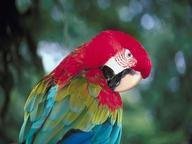Quiz Answer Key and Fun Facts
1. Our first fashionable bird is modelling a grey ensemble that wouldn't look out of place in any office environment. It is also showing off a range of bright-red tail feathers and a neat mask of white feathers around the eyes. To which species does it belong?
2. The next bird down the birdwalk is Ara ararauna - one of the largest members of the parrot family. It is native to the tropical forests of South America, but many others are found in captivity right around the world. Can you name it?
3. Lophochroa leadbeateri, which is gracefully displaying a collection of delicate salmon-pink feathers, creates a murmur of surprise when it is introduced to the birdwalk audience under which distinctly military-sounding name?
4. This cheeky little bird halted its sashay down the birdwalk in order to give the cameras a close-up view of the feathered face for which it is named. What is it?
5. The elegant Platycercus elegans strides onto the birdwalk and proceeds to give the audience a good view of its stylish red and blue plumage. It is known by a wide range of common names - which of the options below is one of them?
6. As Psitteuteles versicolor embarks on its parade down the birdwalk, it appears to be at bit wide-eyed at its somewhat unusual surroundings. It is normally found in the forests of northern Australia, under what common name?
7. This bird has apparently seen red (presumably after looking at its feathery outfit) and retreated to a high perch above the birdwalk in order to angrily glare down at the audience. It is obviously a somewhat temperamental example of Ara macao, better known by what common name?
8. What is the common name given to this regal bird, whose ensemble of red and green feathers identifies him as a male of the species?
9. This rose-breasted cockatoo will likely be making a special effort not to trip up on the birdwalk and end up looking foolish or idiotic. Which of these options is another name for this bird?
10. The final member of the parrot family to grace the birdwalk is exhibiting a classic look with predominantly black feathers accessorised by a red flash in its tail. This Australian bird is the male of which species?
Source: Author
Fifiona81
This quiz was reviewed by FunTrivia editor
Tizzabelle before going online.
Any errors found in FunTrivia content are routinely corrected through our feedback system.


